The books reviewed this week include eye-catching illustrated anthologies of poems, written in various poetic forms, that tell stories and convey information on a variety of topics. There is also a multi-voiced historical novel in verse that will engage and ignite the interest of older readers. Reading aloud the poems in these collections will encourage an appreciation of the beauty and power of poetry.
Ages 4–8
Blooming Beneath the Sun. Christina Rossetti. Ill. Ashley Bryan. 2019. Caitlyn Dlouhy/Atheneum/Simon & Schuster.
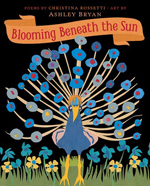 Thirteen poems by Christina Rossetti (1830–1894) with lively language and rhyme schemes are accompanied by Ashley Bryan’s whimsical, colorful cut-construction paper art. For example, the poem “I Dreamt I Caught a Little Owl” is spotlighted by collage artwork of a colorful, mostly blue owl for the lines “I dreamt I caught a little owl / And the bird was—blue” / “But you may hunt for ever / And not find such a one.” On the facing page, featuring a red sunflower against a bright yellow background, the poem finishes with “I dreamt I set a sunflower, / and red as blood it grew—” / “But such a sunflower never / Bloomed beneath the sun.” The book concludes with a biographical note about Rossetti’s life and work.
Thirteen poems by Christina Rossetti (1830–1894) with lively language and rhyme schemes are accompanied by Ashley Bryan’s whimsical, colorful cut-construction paper art. For example, the poem “I Dreamt I Caught a Little Owl” is spotlighted by collage artwork of a colorful, mostly blue owl for the lines “I dreamt I caught a little owl / And the bird was—blue” / “But you may hunt for ever / And not find such a one.” On the facing page, featuring a red sunflower against a bright yellow background, the poem finishes with “I dreamt I set a sunflower, / and red as blood it grew—” / “But such a sunflower never / Bloomed beneath the sun.” The book concludes with a biographical note about Rossetti’s life and work.
—NB
Clackety Track: Poems About Trains. Skila Brown. Ill. Jamey Christoph. 2019. Candlewick.
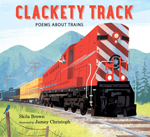 Skila Brown’s 13 poems about trains ranging from sleeper trains to zoo trains and everything in between will entertain and inform young readers. As they are whisked down the track on a bullet train and sprayed with snow by a train snowplow, young children learn railroad-related vocabulary (words like pantograph and tethered in the poem “Electric Train”) and word play (such as how to “unpack your appetite” in “Dinner Train”). Brown includes 12 train facts at the end of the book, such as “The U.S. is divided into time zones because it once made travel by train easier to schedule.” Jamey Christoph adds detailed retro-style digital art to this delightful read-aloud poetry.
Skila Brown’s 13 poems about trains ranging from sleeper trains to zoo trains and everything in between will entertain and inform young readers. As they are whisked down the track on a bullet train and sprayed with snow by a train snowplow, young children learn railroad-related vocabulary (words like pantograph and tethered in the poem “Electric Train”) and word play (such as how to “unpack your appetite” in “Dinner Train”). Brown includes 12 train facts at the end of the book, such as “The U.S. is divided into time zones because it once made travel by train easier to schedule.” Jamey Christoph adds detailed retro-style digital art to this delightful read-aloud poetry.
—SK
In the Middle of the Night: Poems from a Wide-Awake House. Laura Purdie Salas. Ill. Angela Matteson. WordSong/Highlights.
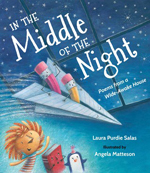 In a series of poems, Laura Purdie Salas imagines what happens to objects in a house after lights out. Stuffed animals put on a talent show in “Animals on the Go,” and a variety of household objects including a comb, Kleenex, a mixing bowl, and a marker missing its cap also come to life. An overdue book sneaks around to tease. “I creep to your closet / I burrow. I sneak. / I LOVE to play overdue-book / hide and seek!” The book ends with a good morning poem for two voices. Angela Matteson’s cheerful and lively illustrations add to the playfulness of the poems through personification of the wide-awake objects.
In a series of poems, Laura Purdie Salas imagines what happens to objects in a house after lights out. Stuffed animals put on a talent show in “Animals on the Go,” and a variety of household objects including a comb, Kleenex, a mixing bowl, and a marker missing its cap also come to life. An overdue book sneaks around to tease. “I creep to your closet / I burrow. I sneak. / I LOVE to play overdue-book / hide and seek!” The book ends with a good morning poem for two voices. Angela Matteson’s cheerful and lively illustrations add to the playfulness of the poems through personification of the wide-awake objects.
—SK
Lion of the Sky: Haiku for All Seasons. Laura Purdie Salas. Ill. Mercè López. 2019. Millbrook/Lerner.
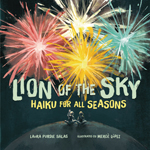 Readers will have fun trying to solve each of the clever “riddle-kus,” combinations of a riddle, haiku, and mask poem in which something nonhuman narrates or speaks, in Laura Purdie Salas’ collection of seasonal poems. Entries include “fire in our bellies, / we FLICKER-FLASH in twilight— / rich meadow of stars” (a firefly) and “I’m cold confetti / falling from a crystal sky, / blanketing the town (snow in a snow globe). Mercè López’ beautiful illustrations (created in acrylics and finished digitally) give visual hints for solving the riddle-kus. The author includes instructions on how readers can try writing their own “riddle-kus,” a list of poetry collections (Haiku, Riddle Poems, and Seasons) for further reading, and an answer key to the 24 narrators.
Readers will have fun trying to solve each of the clever “riddle-kus,” combinations of a riddle, haiku, and mask poem in which something nonhuman narrates or speaks, in Laura Purdie Salas’ collection of seasonal poems. Entries include “fire in our bellies, / we FLICKER-FLASH in twilight— / rich meadow of stars” (a firefly) and “I’m cold confetti / falling from a crystal sky, / blanketing the town (snow in a snow globe). Mercè López’ beautiful illustrations (created in acrylics and finished digitally) give visual hints for solving the riddle-kus. The author includes instructions on how readers can try writing their own “riddle-kus,” a list of poetry collections (Haiku, Riddle Poems, and Seasons) for further reading, and an answer key to the 24 narrators.
—SK
The Proper Way to Meet a Hedgehog and Other How-To Poems. Paul B. Janeczko (Ed.). Ill. Richard Jones. 2019. Candlewick.
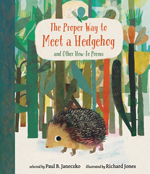 Paul B. Janeczko’s anthology offers young children a delightful variety of how-to poems by 33 classic and contemporary poets. Selections include Christina Rossetti’s “Mix a Pancake” (“Mix a pancake, / Stir a pancake, / Pop it in the pan; / Fry the pancake, / Toss the pancake— / Catch it if you can.”); Nikki Grimes’ “A Lesson from the Deaf” with the first verse “First, sweep one hand / up to your mouth, as if to blow a velvet kiss. / Like this.”; and the closing poem, a couplet, “How to Pay Attention” by April Halprin Wayland with the best how-to advice of all for everyone, “Close this book. / Look.” Richard Jones’ colorful, playful illustrations, rendered in paint and digitally edited, complement this collection of poems that are perfect for reading aloud.
Paul B. Janeczko’s anthology offers young children a delightful variety of how-to poems by 33 classic and contemporary poets. Selections include Christina Rossetti’s “Mix a Pancake” (“Mix a pancake, / Stir a pancake, / Pop it in the pan; / Fry the pancake, / Toss the pancake— / Catch it if you can.”); Nikki Grimes’ “A Lesson from the Deaf” with the first verse “First, sweep one hand / up to your mouth, as if to blow a velvet kiss. / Like this.”; and the closing poem, a couplet, “How to Pay Attention” by April Halprin Wayland with the best how-to advice of all for everyone, “Close this book. / Look.” Richard Jones’ colorful, playful illustrations, rendered in paint and digitally edited, complement this collection of poems that are perfect for reading aloud.
—NB
Ages 9–11
Boom! Bellow! Bleat!: Animal Poems for Two or More Voices. Georgia Heard. Ill. Aaron DeWitt. 2019. WordSong/Highlights.
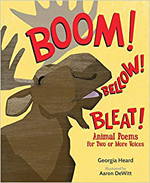 In 13 poems to be read aloud by two or more readers, Georgia Heard partners with illustrator Aaron DeWitt as she incorporates descriptions into her onomatopoetic arrangements of sounds that various animals make. In “Rattlesnake Warning,” for example, “Stay / away; / I’m / warning / you” and each of the following three verses are paired with the answering “chhhhh-chhhhh-chhhhh / chhhhh-chhhhh-chhhhh / chhhhhchhhhhhchhhhhchhhhhhchhhhh” in undulating letters on the left side of the double-page spread. On the opposing page, there’s a large tan, black, and white snake, mouth stretched wide open and the words “I’LL BITE!” Color-coded lines make it easier to identify alternating voices, and some poems include performance instructions for readers. The book concludes with Nature’s Notes detailing information about the animals and their sounds explored in these fun read-aloud poems.
In 13 poems to be read aloud by two or more readers, Georgia Heard partners with illustrator Aaron DeWitt as she incorporates descriptions into her onomatopoetic arrangements of sounds that various animals make. In “Rattlesnake Warning,” for example, “Stay / away; / I’m / warning / you” and each of the following three verses are paired with the answering “chhhhh-chhhhh-chhhhh / chhhhh-chhhhh-chhhhh / chhhhhchhhhhhchhhhhchhhhhhchhhhh” in undulating letters on the left side of the double-page spread. On the opposing page, there’s a large tan, black, and white snake, mouth stretched wide open and the words “I’LL BITE!” Color-coded lines make it easier to identify alternating voices, and some poems include performance instructions for readers. The book concludes with Nature’s Notes detailing information about the animals and their sounds explored in these fun read-aloud poems.
—NB
The Day the Universe Exploded My Head: Poems to Take You into Space and Back Again. Allan Wolf. Ill. Anna Raff. 2019. Candlewick.
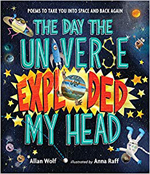 Readers will learn many facts about outer space while being entertained by Allan Wolf’s humorous and clever poems, some to be read aloud by up to four voices, as well as a thought-provoking poem, “For Those Who Light the Candle,” about the astronauts and cosmonauts who gave their lives to further space exploration. The poem “The Sun Did Not Go Down Today” explains “The sun remains there in the sky / and waves at us as we go by / on our spherical, miracle merry-go-round.” Wolf’s “Mars: A Martian Sonnet” speaks to the possibly-not-so-distant future: “From afar I seem harsh, but I bid you ‘Shalom!’ / Someday in the future you may call me home.” Anna Raff’s digitally assembled collages add fun and color to the poems. Wolf also includes notes on the poems, a glossary of selected space terms, and internet resources to enhance learning.
Readers will learn many facts about outer space while being entertained by Allan Wolf’s humorous and clever poems, some to be read aloud by up to four voices, as well as a thought-provoking poem, “For Those Who Light the Candle,” about the astronauts and cosmonauts who gave their lives to further space exploration. The poem “The Sun Did Not Go Down Today” explains “The sun remains there in the sky / and waves at us as we go by / on our spherical, miracle merry-go-round.” Wolf’s “Mars: A Martian Sonnet” speaks to the possibly-not-so-distant future: “From afar I seem harsh, but I bid you ‘Shalom!’ / Someday in the future you may call me home.” Anna Raff’s digitally assembled collages add fun and color to the poems. Wolf also includes notes on the poems, a glossary of selected space terms, and internet resources to enhance learning.
—SK
Predator and Prey: A Conversation in Verse. Susannah Buhrman-Deever. Ill. Bert Kitchen. 2019. Candlewick Studio/Candlewick.
 Science meets poetry in these conversations in verse between predator and prey, who both just want to stay alive and raise their young. In the pairing of the poems “Hot-Tempered Squirrel” and “Patience of a Snake,” for example, readers learn how the squirrel often wins the battle with a rattlesnake by simply confronting the snake and asserting itself. “I’m hot / and bothered. / I’m hot / under the collar. / I’m fur-rious F U R I O U S ! / Flag waving, / I boldly scold: / ‘Hey, you! Get off my lawn!’” A text box with scientific information about the predator and prey accompanies each conversation in verse. Bert Kitchen’s brightly colored illustrations, done in watercolor and gouache, portray that suspenseful moment when predator and prey meet.
Science meets poetry in these conversations in verse between predator and prey, who both just want to stay alive and raise their young. In the pairing of the poems “Hot-Tempered Squirrel” and “Patience of a Snake,” for example, readers learn how the squirrel often wins the battle with a rattlesnake by simply confronting the snake and asserting itself. “I’m hot / and bothered. / I’m hot / under the collar. / I’m fur-rious F U R I O U S ! / Flag waving, / I boldly scold: / ‘Hey, you! Get off my lawn!’” A text box with scientific information about the predator and prey accompanies each conversation in verse. Bert Kitchen’s brightly colored illustrations, done in watercolor and gouache, portray that suspenseful moment when predator and prey meet.
—SK
Ages 12–14
The Undefeated. Kwame Alexander. Ill. Kadir Nelson. 2019. Houghton Mifflin Harcourt.
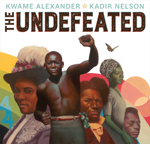 In this ode to African American dreamers and doers, Kwame Alexander remembers black Americans including the unforgettable, the unafraid, and the undefeated. “This is for the / undefeated. / This is for you. / And you. / And YOU. / This / is / for / US.” Kadir Nelson’s stunning oil portraits of African Americans, created on panels, complement Alexander’s tribute to sung and unsung heroes. In an afterword, Alexander adds the inspirational note that to “truly know who we are as a country, we have to accept and embrace all our woes and wonders” and encourages readers “to never, ever give up.” Back matter includes a “Historical Figures and Events Featured in The Undefeated” section and a free audio access link and code to Kwame Alexander’s performance of the poem.
In this ode to African American dreamers and doers, Kwame Alexander remembers black Americans including the unforgettable, the unafraid, and the undefeated. “This is for the / undefeated. / This is for you. / And you. / And YOU. / This / is / for / US.” Kadir Nelson’s stunning oil portraits of African Americans, created on panels, complement Alexander’s tribute to sung and unsung heroes. In an afterword, Alexander adds the inspirational note that to “truly know who we are as a country, we have to accept and embrace all our woes and wonders” and encourages readers “to never, ever give up.” Back matter includes a “Historical Figures and Events Featured in The Undefeated” section and a free audio access link and code to Kwame Alexander’s performance of the poem.
—NB
Ages 15+
Voices: The Final Hours of Joan of Arc. David Elliott. 2019. Houghton Mifflin Harcourt.
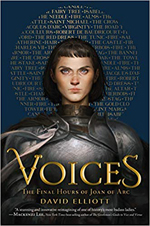 Joan of Arc (1412–1431) was only 13 when she received her first vision and 16 at the Trial of Condemnation (which sentenced to her to death for heresy). David Elliott’s historical novel in verse opens with an excerpt from the Trial of Nullification (that declared her innocent 20 years after her death) and includes poems from multiple points of view beginning with the candle as it sparks the flames that will burn Joan at the stake. The final poem, in Joan’s voice, begins with the words “I am come to the end. My saints / will not save me. I surrender / to the fire that craves me” and ends with “I was the Maid of Orléans. / I was a girl called Joan.” An epilogue concludes with “Yet all agree she burned too bright, / lost in the blinding glare of the sun, / alone in the sacred light.” In an author’s note. Elliott cross-references poetic forms including the ballade, rondeau, rondel, sestina, villanelle, haiku, and shape poem in the book.
Joan of Arc (1412–1431) was only 13 when she received her first vision and 16 at the Trial of Condemnation (which sentenced to her to death for heresy). David Elliott’s historical novel in verse opens with an excerpt from the Trial of Nullification (that declared her innocent 20 years after her death) and includes poems from multiple points of view beginning with the candle as it sparks the flames that will burn Joan at the stake. The final poem, in Joan’s voice, begins with the words “I am come to the end. My saints / will not save me. I surrender / to the fire that craves me” and ends with “I was the Maid of Orléans. / I was a girl called Joan.” An epilogue concludes with “Yet all agree she burned too bright, / lost in the blinding glare of the sun, / alone in the sacred light.” In an author’s note. Elliott cross-references poetic forms including the ballade, rondeau, rondel, sestina, villanelle, haiku, and shape poem in the book.
—NB
Susan Knell is a professor in the Department of Teaching and Leadership at Pittsburg State University in Pittsburg, Kansas, where she teaches literacy and literature courses at the undergraduate and graduate level. Nancy Brashear is Professor Emeritus of English at Azusa Pacific University in Azusa, California